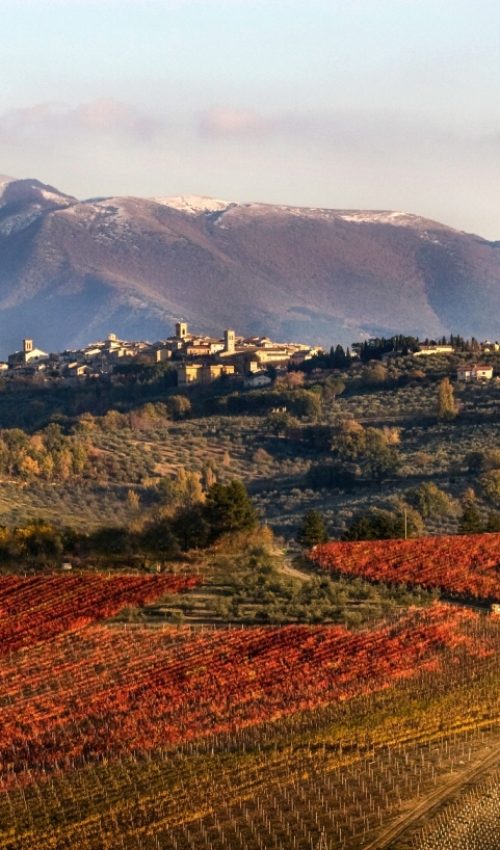
Production Areas
PRODUCTION AREAS

PRODUCTION AREA OF THE DOC AND DOCG WINES OF MONTEFALCO
The geographical area of production of Montefalco encompasses the entire municipal territory of Montefalco from which is named after and part of Bevagna, Giano dell’Umbria, Gualdo Cattaneo, Castel Ritaldi; all in the province of Perugia, in the heart of Umbria. It is a very small production area, with gentle slopes surrounded by ancient medieval villages.

PRODUCTION AREA OF DOC SPOLETO WINES
The grapes for the production of wines that fall under the Spoleto DOC must be grown in the area delimited by the disciplinary: the entire territory of the municipality of Montefalco and part of those of Campello sul Clitunno, Castel Ritaldi, Foligno, Spoleto and Trevi. All the municipalities are located in the province of Perugia, alternating valleys and mild hills.




PRODUCTION AREA OF
THE DOC AND DOCG
WINES OF MONTEFALCO
The geographical area of production of Montefalco encompasses the entire municipal territory of Montefalco from which is named after and part of Bevagna, Giano dell’Umbria, Gualdo Cattaneo, Castel Ritaldi; all in the province of Perugia, in the heart of Umbria. It is a very small production area, with gentle slopes surrounded by ancient medieval villages.
PRODUCTION AREA OF
DOC SPOLETO WINES
The grapes for the production of wines that fall under the Spoleto DOC must be grown in the area delimited by the disciplinary: the entire territory of the municipality of Montefalco and part of those of Campello sul Clitunno, Castel Ritaldi, Foligno, Spoleto and Trevi. All the municipalities are located in the province of Perugia, alternating valleys and mild hills.
TERRITORIAL AND CLIMATIC CONDITIONS OF MONTEFALCO AREA



The soils composition in Montefalco production area, with slight variations from place to place, are mainly calcareousclay, sometimes deeper and sometimes lighter, with limited presence of skeleton. The altitude ranges from 220 to 472 meters a.s.l., while slope and exposures are variable, so creating a puzzle of microclimates and conditions.

THE PRODUCTION AREA IS CHARACTERIZED, IN TERMS OF SOIL COMPOSITION, BY 4 SUB-ZONES:
Fluvial - lacustrine conglomerates: yellow sands with some cemented conglomerates (Plio - Pleistocene). There are remarkable outcrops all around Montefalco, at S. Clemente, Camiano, Turrita, Cerrete, Pietrauta, Vallo, S. Quirico.
Clays and lacustrine sands (Plio - Pleistocene): under Limigiano, south-west of Bevagna, in Bastardo, Cantinone and south of Turrita, up to Torregrosso.
Alluvial: current and recent alluvial layers along with those at the lower terrace, predominantly sand-pebbly (Holocene), correspond to the plain surfaces with an extension (in a transverse direction) ranging from a few hundred meters to a few kilometers (such as in Cantalupo, Bevagna, La Bruna), and more ancient deposits of raised terraces from 5 to 50 meters, on the current riverbed (Pleistocene) as well as at south-west of Montefalco (Madonna della Stella).
Marls: large areas present outcrops of rocks from the Miocene age; there are yellowish sandstones and greyish silt marls, usually in regular alternation, typical of the marl-arenaceous formation (of Tortoniano - Langhiano), and other similar lithotypes (Bisciaro). There are also sandstones attributable to the formation of Macigno (Langhiano - Oligocene), levels and lenses, of variable size and power, greyish silty clays, marls (like polychrome schists), limestone, calcarenites and calcirudites (type Nummulitic).

TERRITORIAL AND CLIMATIC CONDITIONS OF MONTEFALCO AREA

The soils composition in Montefalco production area, with slight variations from place to place, are mainly calcareousclay, sometimes deeper and sometimes lighter, with limited presence of skeleton. The altitude ranges from 220 to 472 meters a.s.l., while slope and exposures are variable, so creating a puzzle of microclimates and conditions.
The soils composition in Montefalco production area, with slight variations from place to place, are mainly calcareousclay, sometimes deeper and sometimes lighter, with limited presence of skeleton. The altitude ranges from 220 to 472 meters a.s.l., while slope and exposures are variable, so creating a puzzle of microclimates and conditions.
THE PRODUCTION AREA IS CHARACTERIZED, IN TERMS OF SOIL COMPOSITION, BY 4 SUB-ZONES:
Fluvial - lacustrine conglomerates: yellow sands with some cemented conglomerates (Plio - Pleistocene). There are remarkable outcrops all around Montefalco, at S. Clemente, Camiano, Turrita, Cerrete, Pietrauta, Vallo, S. Quirico.
Clays and lacustrine sands (Plio - Pleistocene): under Limigiano, south-west of Bevagna, in Bastardo, Cantinone and south of Turrita, up to Torregrosso.
Alluvial: current and recent alluvial layers along with those at the lower terrace, predominantly sand-pebbly (Holocene), correspond to the plain surfaces with an extension (in a transverse direction) ranging from a few hundred meters to a few kilometers (such as in Cantalupo, Bevagna, La Bruna), and more ancient deposits of raised terraces from 5 to 50 meters, on the current riverbed (Pleistocene) as well as at south-west of Montefalco (Madonna della Stella).
Marls: large areas present outcrops of rocks from the Miocene age; there are yellowish sandstones and greyish silt marls, usually in regular alternation, typical of the marl-arenaceous formation (of Tortoniano - Langhiano), and other similar lithotypes (Bisciaro). There are also sandstones attributable to the formation of Macigno (Langhiano - Oligocene), levels and lenses, of variable size and power, greyish silty clays, marls (like polychrome schists), limestone, calcarenites and calcirudites (type Nummulitic).
The soils composition in Montefalco production area, with slight variations from place to place, are mainly calcareousclay, sometimes deeper and sometimes lighter, with limited presence of skeleton. The altitude ranges from 220 to 472 meters a.s.l., while slope and exposures are variable, so creating a puzzle of microclimates and conditions.
THE PRODUCTION AREA IS CHARACTERIZED, IN TERMS OF SOIL COMPOSITION, BY 4 SUB-ZONES:
Fluvial - lacustrine conglomerates: yellow sands with some cemented conglomerates (Plio - Pleistocene). There are remarkable outcrops all around Montefalco, at S. Clemente, Camiano, Turrita, Cerrete, Pietrauta, Vallo, S. Quirico.
Clays and lacustrine sands (Plio - Pleistocene): under Limigiano, south-west of Bevagna, in Bastardo, Cantinone and south of Turrita, up to Torregrosso.
Alluvial: current and recent alluvial layers along with those at the lower terrace, predominantly sand-pebbly (Holocene), correspond to the plain surfaces with an extension (in a transverse direction) ranging from a few hundred meters to a few kilometers (such as in Cantalupo, Bevagna, La Bruna), and more ancient deposits of raised terraces from 5 to 50 meters, on the current riverbed (Pleistocene) as well as at south-west of Montefalco (Madonna della Stella).
Marls: large areas present outcrops of rocks from the Miocene age; there are yellowish sandstones and greyish silt marls, usually in regular alternation, typical of the marl-arenaceous formation (of Tortoniano - Langhiano), and other similar lithotypes (Bisciaro). There are also sandstones attributable to the formation of Macigno (Langhiano - Oligocene), levels and lenses, of variable size and power, greyish silty clays, marls (like polychrome schists), limestone, calcarenites and calcirudites (type Nummulitic).
with warm but not arid summers and cold winters, average level of rainfalls.
On average, summer temperatures range between 18 and 23 ° C and winter ones between 4 and 6 ° C;
annual rainfalls are between 750 and 1300 millimeters,
with maximum levels in summer and minimum levels in autumn.

